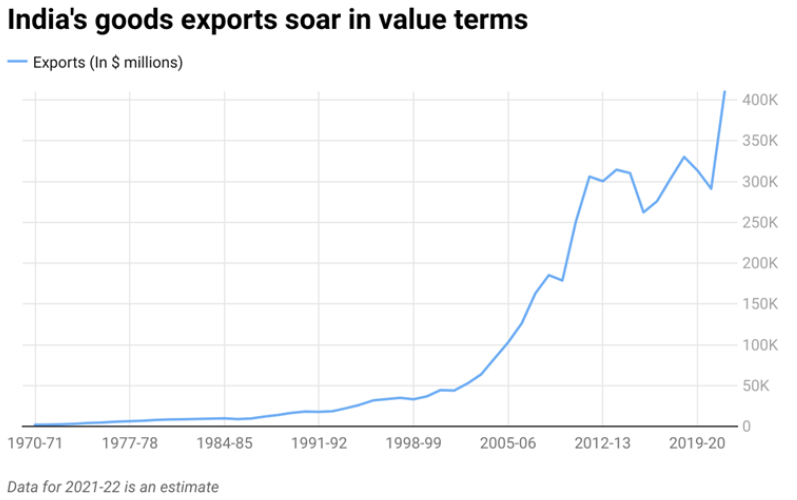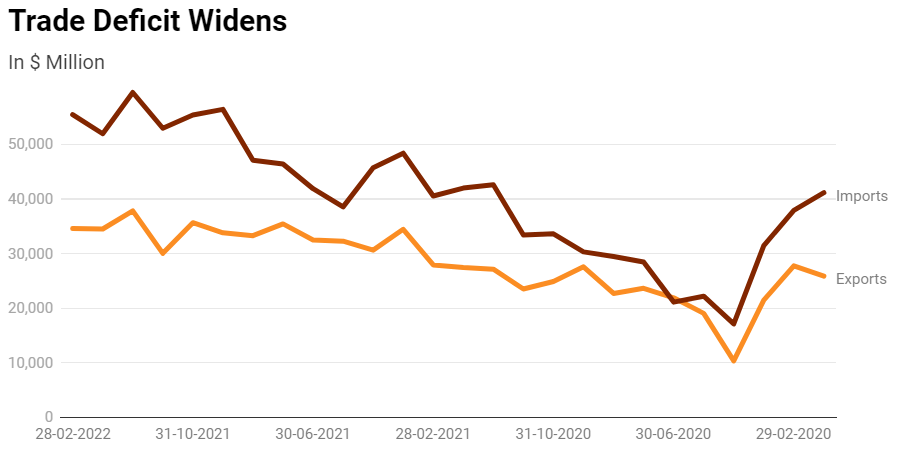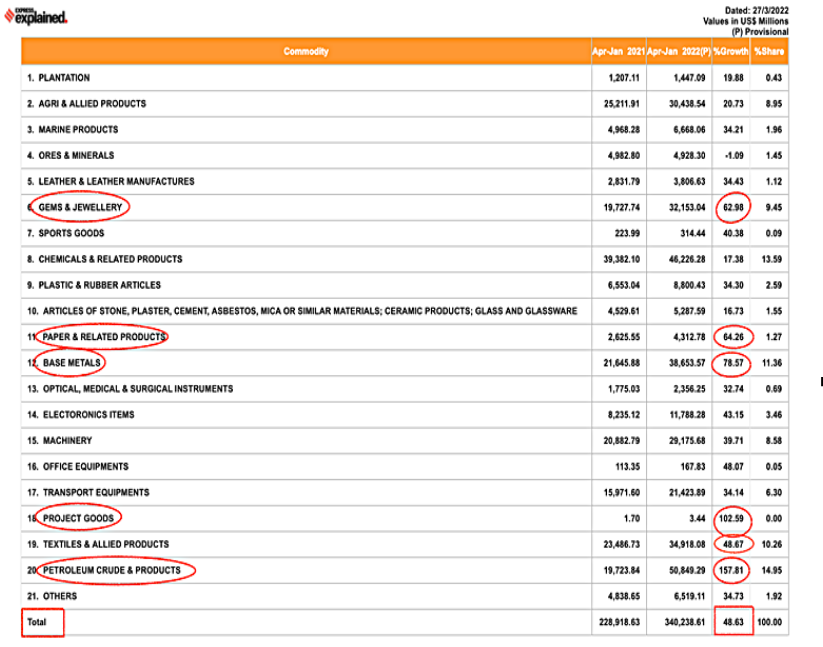India’s Export Sector
2022 MAR 28
Mains >
Economic Development > Indian Economy and issues > External sector
IN NEWS:
- On March 21, the value of India’s outbound shipments in the financial year 2021-22 hit USD 400 billion, the highest ever.
MORE ON THE NEWS:
- It is expected that exports will reach USD 410 billion by the end of March, 2022. This would translate into a growth of about 41% from the pandemic-hit year of 2020-21, making it India’s fastest exports growth rate since 2009-10.
- Engineering goods, petroleum products, gems and jewellery, chemicals and ready-made garments of all textiles were the top five commodities exported from India.
WHY THE SURGE:

- Aversion to China:
- Before COVID, global supply chains were massively dependent on China. But concerns over the pandemic’s origin created a global sentiment of not wanting to be exclusively dependent on China. This is resulting in a supply chain reorganisation and India is gaining from this.
- Policy measures by the government:
- There was a detailed strategy in place — including specific country-wise, and product-wise targets, monitoring and course correction — to promote exports and attain the export target.
- Global integration of domestic industries:
- Government took several measures such as Product Linked Incentives scheme, new labour laws and offers of land pools to attract investment and enhance domestic production. This has helped the domestic manufacturing industry become more integrated into global value chains.
SIGNIFICANCE OF EXPORTS:
- Attain Atmanirbhar:
- Besides attaining the USD 400 billion target in March, India was also seen to be exporting more of high-value and value-added products. This highlights that India is taking a step closer to being “atmanirbhar”.
- Foster domestic growth:
- Exports are a significant contributor to employment generation, boost manufacturing and also help in enhancing GDP levels.
- They also help to elevate MSMEs who form an integral part of the economy. Eg: The share of export of specified MSME related products to All India exports during 2020-21 was 49.5%.
- Development of secondary sector:
- Whilst India has done well in the services sector exports, manufacturing exports have been less. However, in F22, the export of engineering goods rose by 50% and electronic goods jumped 41%, which indicates that exports is fueling the development of manufacturing industries.
- Improve productivity:
- In order to remain competitive in the international market, export-oriented industries adopt innovate, technology-oriented production and processing methodologies. This can promote research and development and help create cost effective and quality products within the country.
- Promote international cooperation:
- Good trade relations aid in fostering strong bilateral and regional cooperation. For instance, good trade relation is a major reason for the cordial relations between India and the US, despite having differences in matters like Ukraine crisis.
CHALLENGES IN EXPORT SECTOR:
- Trade deficit:
- Even though exports have risen, the monthly trade deficit has been spiking recently and had hit a record USD 22.9 billion in November 2021.
- India imports 80% of its oil and demand is likely to grow as the economic recovery picks up pace. Hence, the deficit is expected to increase in the coming months.

- Low levels of exports as a percentage of GDP
- Despite the record export figure, India’s merchandise exports to GDP ratio have been on a declining trend. It stood at 10.94% in FY21, falling from 11.07% the previous year and 12.2% in FY19.
.png)
- Not a broad-based recovery:
- Of the 20 commodity groups, only six (highlighted by red circles) had a growth rate higher than the overall average (49%). This indicates that its share in India’s export basket would have reduced relative to the previous year.

- Low volume of export:
- India’s biggest export item was petroleum and petroleum products — accounting for 15% of total exports. But due to the rising crude oil prices, their value was high. Hence, the USD 400 billion figure, which essentially refers to the value of exports, can be misleading.
- Traditional export basket:
- Our export basket is predominantly traditional and does not comprise cutting-edge products. As much as 70% of India’s exports target 30% of world trade comprising items with a declining global share. Hence, India’s share in global merchandise trade remains at < 2%.
- Geopolitical tensions:
- The Ukraine crisis has resulted in high shipping rates, container shortages and re-alignment of trade routes around the Black Sea. This will pose a challenge to India’s exports to Europe and Central Asia.
- The Ukraine crisis can result in a sharp rise in India’s energy import bill as well as an uptick in costs of importing edible oils like sunflower oil, whose production is dominated by the two nations at war.
- High logistics cost:
- Fragmented supply chain, underdeveloped material handling infrastructure, cross-subsidisation of power, presence of multiple regulatory agencies etc. has resulted in high logistics cost. It is 14%-16% of India’GDP, compared to 8%-10% of GDP in China and 12%-13% in the US. This hinders the competitiveness of Indian products in international markets.
- Weak MSME sector:
GOVERNMENT MEASURES:
- Foreign trade policy 2015-2020:
- FTP 2015-20 provides a framework for increasing exports of goods and services as well as generation of employment and increasing value addition in the country, in line with the ‘Make in India’ programme.
- The government has recently extended the Policy by six months to March 31, 2022.
- Remission of Duties and Taxes on Export Products (RoDTEP) Scheme
- It is a scheme that replaced the existing Merchandise Exports from India Scheme. The scheme will ensure that the exporters receive the refunds on the embedded taxes and duties previously non-recoverable.
- Support under Atma Nirbhar Bharat Abhiyan:
- Rs 3,000 Crore boost is being provided to EXIM Bank for promoting project exports under Indian Development and Economic Assistance Scheme (IDEAS Scheme). This will help EXIM Bank facilitate Lines of Credit development assistance activities and promote exports from India.
- Make in India:
- The Make in India initiative was launched in September 2014 to transform India into a global design and manufacturing hub.
- It had three stated objectives:
- to increase the manufacturing sector's growth rate to 12-14% per annum.
- to create 100 million additional manufacturing jobs in the economy by 2022.
- to ensure that the manufacturing sector's contribution to GDP is increased to 25% by 2022 (later revised to 2025).
- Production-linked Incentive (PLI) scheme
- Forex reserves:
- Dedicated export zones:
- India has established several geographical zones to promote production and exports, like Special Economic Zones, coastal economic zone, Delhi-Mumbai Industrial Corridor, National Investment and Manufacturing Zone, Agri Export Zone, food park and textile park.
- Revamping SEZs In India: https://www.ilearncana.com/details/Revamping-SEZs-in-India/2960
- Investor friendly policies:
- The corporate tax rate has been lowered to 22% for all firms and 15% for new manufacturing firms, so as to encourage the domestic manufacturing sector.
- As many as 29 Central labour laws were rationalised into four codes.
- The definitions of MSMEs have been revised to allow them to grow in size, whilst maintaining the benefits of MSMEs.
WAY FORWARD:
- Foreign Trade Policy 2021-2026:
- Government needs to create a new FTP, taking into consideration the realities of the post-covid world.
- Conclude FTAs:
- A swift conclusion of Free Trade Agreement pacts being negotiated with countries like the U.K., Australia and Canada, could create easier market access in these large markets.
- Expand RoDTEP Scheme:
- In order to promote exports, a parliamentary committee has urged the government to include Special Economic Zones and sectors such as pharma, steel, and chemicals under the Remission of Duties and Taxes on Export Products (RoDTEP) Scheme.
- Reduce logistics cost:
PRACTICE QUESTION:
Q. The possibility of a sharp recovery for the economy can only be realised through a strong focus on exports. In this regard, discuss the challenges faced by export sector. What measures have the government taken to promote exports from India?


.png)
